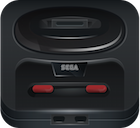
Unlike the original Master System or SG-1000 systems, SEGA provided third party developers with some tools to make Mega Drive development easier.
There are still Sega Mega Drive SDK files that have never been archived or released on the internet unfortunately, so this post will only cover the files we have access to.
The following files have been released to the internet over time:
The files in this section are from the Sega Mega Family.7z archive as they are much easier to use when in pdf format. The Sega SDK.zip archive contains the same contend but each page is a separate .gif file.
Before we look at the files we have access to lets have a look at the files that are known about but that have never been archived.
SEGA developed some tools for Apple Macintosh computers for editing sound and potentially graphics too.
The only documentation we have for the standard (non add-on) Sega Mega Drive development are:
For low level technical information about how the Genesis works the Genesis Software Manual document is worth a read, but it’s not information that you can’t find in a better form elsewhere.
The Game standards document (Sega Software Development and Game Standards.pdf) is an interesting read, it is surprising how specific the game standards were, and it is why so many games looked the same during the startup and title screens. It even includes specifications for Continue/Game over sections and a password screen.
The Sega Mega Family.7z archive contains a few interesting documents on how Sound was produced for the Sega Mega Drive, which are listed in the table below.
| Name | Description |
|---|---|
| 68000 Sound Driver Ver 3.00.pdf | Documentation for the 32x sound driver (PCM) |
| Genesis Sound Software Manual.pdf | Contains Z80 memory Map, how to communicate with the Main 68K CPU, envelope specification and Programmable Sound generator information |
| MIDI Converter Ver 1.30.pdf | Documentation for a few Macintosh tools that convert standard MIDI files into multiple formats |
In order to test games on the retail Genesis hardware a few development cartridges were sold to developers which act like flash cartridges.
In the Sega Mega Family.7z archive there are three manuals for these cartridges listed in the table below.
| Name | Description |
|---|---|
| IC BD 16M 42 PIN 4 EPROM 32X RD 837-11070 User’s Manual.pdf | Documentation for the 16Mbit EPROM based development cartridge for the 32X |
| IC BD 32M SRAM + 256K BUP 32X RD 837-11068 User’s Manual.pdf | documentation for the SRAM based development cartridge with 32Mbit of space |
| IC BD 4M 32 PIN 8 EPROM 32X RD 837-11069 User’s Manual.pdf | Documentation for the 32Mbit EPROM based development cartridge for the 32X |
The folder Bulletins inside the archive contains a number of scanned emails that SEGA of America sent out to all registered Genesis developers.
| Name | Description |
|---|---|
| Addendum | Contains a few additional specifications, including custom joysticks via the I/O port, DMA, H-Blank and V-Blank interrupts and details about communication between Z80 and the 68K |
| Cinepak | Contains an email sent to Sega Developers in 1994 about Cinepak version 1.2, which must now be used for all future games. This was presumably only for Mega CD and Saturn developers as Cinepak is a video library |
| Gen-tech | Scanned emails from 1991 giving newer information to all Mega Drive developers. Includes assembly code listings for some examples. |
| MCD-tech | SEGA CD specific technical bulletins including information on the US BIOS, information on CD writers and discs, and corrections to the Mega CD documentation |
| Misc | Information about the Super Target hardware and corrections for the software guidelines. |
The most interesting emails are in the Gen-tech folder as they are the earliest known documentation we have on SEGA Mega Drive development.
Technical Bulletin number 32 includes an introduction to XBAND for assing online multiplayer support into your games!
The Sega CD Technical Bulletin number 20 mentions that there are only two approved CD re-writers for SEGA CD content which are:
The first Technical Bulletin mentions some errors with Microtec example code, which has never been archived or distributed online.
It looks like it would be for DOS and It mentions that it has a few files:
The source code to the Japan-only sound driver that was called SOUND-SORCE (incorrect spelling probably due to filename limits?) and was leaked online by Hidden Palace:
This leak suggests that development in Sega of Japan was done on NEC PC-9801 DOS based workstations and since these PCs were only popular in Japan it wouldn’t make sense to send the sound driver source code over to the Sega of America development team.
As for building the Z80 assembly code it required the X68K assembler and the ERX68K simulator environment which would be connected to a ZAX ICD-series in-circuit emulator which could be controlled with a program called ZICE on the NEC PC-9801.